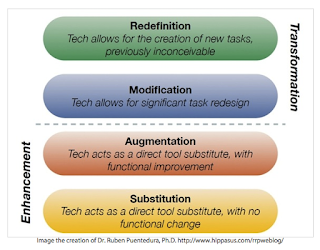Activity 5: My Professional Connection Map
 |
| Created at and retrieved from: http://bubbl.us |
“Only through our connectedness to others can we really know
and enhance the self. And only through working on the self can we begin to
enhance our connectedness to others.” – Harriet Lerner
Connections
Being connected is clearly not a new topic for today’s
people, especially with the endless possibilities our technology allows today.
But there is more to connectedness than social networks.
Personal or professional, having connections is clearly
important to growth and development. As a teacher, my professional connection
is important as it provides opportunities for myself to grow and develop to
benefit my classroom practice.
I have illustrated on the map above both my current and
potential professional connections, with the blue bubbles representing the
benefits and challenges for each connection and red bubbles to represent
potential benefits and connections. For example, a major impact on my practice
comes from my connection with the students I teach, who come with different backgrounds,
cultures, needs and talents. With this connection, there is potential for
students to be in their element and become the source of knowledge in their
area of expertise in the classroom or across the school. I aim to put this into action by setting up regular student-run meetings. Furthermore, my
connection from both the students and the community allows me to have
professional connections with parents, who have the potential of learning
opportunities with various areas of expertise.
Another connection includes the team of teachers in my
syndicate whom I work closely with on a daily basis. This connection allows ideas,
resources, support and expertise to be exchanged and have the potentials of
team teaching and wider connections to schools and teachers to benefit and
positively influence my teaching practice and pedagogy.
Interdisciplinary
Environment- What is it and why use it?
Interdisciplinary, as explored by Mathison & Freeman
(1997), refers to the approach where educators seek to “combine disciplines to
enhance the learning in one or more of the disciplines” (p.11) to allow
application in real life situations because knowledge is connected, not
separate. This is recognised as an essential skills for success in the 21st
century.
Mathison & Freeman (1997) provides some justification
for the practical use of interdisciplinary as providing opportunity to: (p. 24)
- Have more
meaningful relations with students
- Teach
cognitive skills associated with ‘real life’
- Motivate
students
- Increase
student achievement
- Promote
positive attitudes toward subject matter
- Create more
curricular flexibility
- Diminish
scheduling problems
- Integrate
new and rapidly changing information with increased time efficiency.
However I believe it is important to mention that Mathison
& Freeman (1997) explain that although teachers have reported positive experiences
with the interdisciplinary approach, there isn’t enough evidence to actually support
this.
As teachers, we are constantly expected to make decisions on
our feet and improvise because no experience is the same. Connectedness and
interdisciplinary teaching is definitely a step towards the right direction,
but it’s the teachers’ task to determine what is best for the students in
different situations at different times.
Reference:




